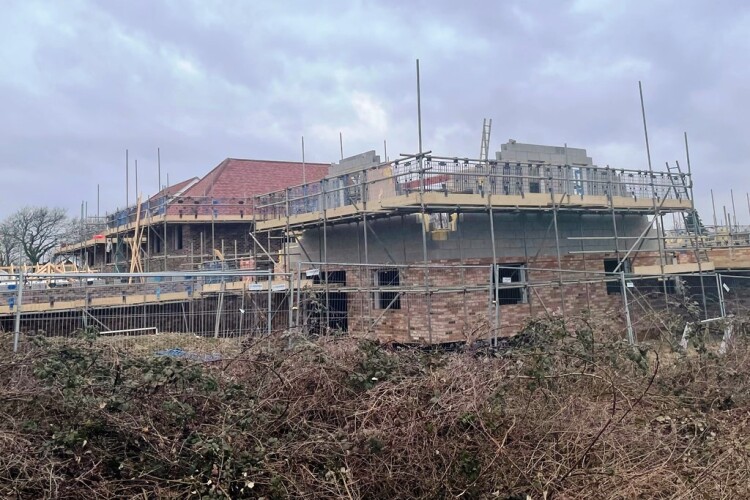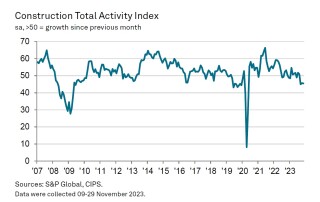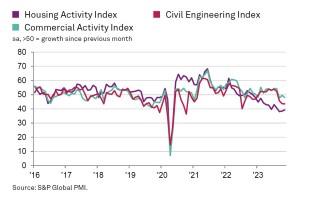While all three major sectors of the industry slowed, the fall in house-building was most acute.
The survey also indicated the steepest reduction in purchasing costs across the construction sector for more than 14 years. This was linked to lower raw material prices, alongside greater competition among suppliers in response to falling demand.
The headline S&P Global / CIPS UK Construction Purchasing Managers’ Index (PMI) registered 45.5 in November, down fractionally from 45.6 in October but still better than September’s 45.0. Any reading below 50 indicates a reduction inactivity.
House-building scored 39.2, civil engineering 43.5 and commercial building 48.1. As noted by Brian Berry, chief executive of the Federation of Master Builders, there has now been a full year of continued decline in house-building, according to these surveys.
November data also suggest a continued lack of new work to replace completed projects. Total new orders decreased for the fourth month running, albeit at the slowest pace since August. Customer hesitancy and greater borrowing costs were often reported as weighing on sales volumes, especially in the housing category.
Business activity expectations for the year ahead picked up from October's recent low, but remained notably weaker than seen in the first half of 2023, the survey authors said. Concerns about the near-term demand outlook contributed to a renewed decline in staffing numbers during November and a marked reduction in purchasing activity. Input buying has now decreased in five of the past six months, largely reflecting reduced workloads and a lack of new project starts. Some firms also commented on destocking efforts in response to improved supply conditions, which led to lower input buying in November.
A combination of greater price competition among suppliers and falling raw material costs contributed to another decrease in input prices across the construction sector. The overall rate of decline was the steepest since July 2009, with survey respondents reporting falling prices paid for a range of materials (especially steel and timber).
Tim Moore, economics director at S&P Global Market Intelligence, which compiles the survey, said: "A slump in house building has cast a long shadow over the UK construction sector and there were signs of weakness spreading to civil engineering and commercial work during November. Residential construction activity has now decreased in each of the past 12 months and the latest reduction was still among the fastest seen since the global financial crisis in 2009. Elevated mortgage costs and unfavourable market conditions were widely cited as leading to cutbacks on house building projects. Rising interest rates and the uncertain UK economic outlook also hit commercial construction in November, while a lack of new work contributed to the fastest decline in civil engineering activity since July 2022.
"Improving supply conditions were evident again in November, linked to rising raw material availability and spare capacity across the supply chain. Greater competition among suppliers added to downward pressure on prices paid for construction products and materials. The latest survey indicated that overall input prices decreased for the second month running and at the fastest rate since July 2009."

John Glen, chief economist at the Chartered Institute of Procurement & Supply (CIPS), said: “There is no doubt that 2023 has been a difficult year for the UK construction sector. Inflated borrowing costs and falling demand have conspired to further slow new building this month.
“Despite this, the sector has finally emerged from a period of intense supply chain pressure and prices are now falling across the board, especially for timber and steel. Projects are no longer being delayed due to unexpectedly high material costs with November seeing the sharpest reduction in purchasing prices since July 2009.
“There will be no quick fixes next year for the sector. Lower demand, elevated interest rates and the prospect of an election promise an uncertain start to 2024. This is a challenging moment for suppliers in the sector, who may have tough price negotiations ahead.”
Federation of Master Builders chief executive Brian Berry said: “Today’s S&P Global/CIPS UK Construction PMI figures mark a full year of continued decline in house building rates in Britain. The civil engineering and commercial sectors are now beginning to show weakness, and with employment rates also decreasing for the first time in ten months, there are worrying signs for the future of the construction industry. If we do not see significant government intervention to substantially boost the UK’s house building rates and ensure that people have access to the high-quality homes they require, this decline is likely to continue
“The positive measures announced in last month’s autumn statement, such as the proposals to speed up planning decisions, and to provide tax cuts to small businesses, indicate an acknowledgment from the government that action is needed. But these proposals alone do not go anywhere near far enough. A wide-reaching, industry specific plan will be necessary to support local house builders to ensure that they can deliver the scale of housing that Britain is currently in desperate need of.”
Fraser Johns, finance director of building contractor Beard, said: “Despite some resilience in the commercial sector, the headlines will continue to focus on house building remaining the weakest performing sector, which continues to have a heavy impact on construction output as a whole. Higher borrowing costs remain a real barrier for this sector, and along with tighter access to credit, is also having an impact in other areas of construction. While it seems the Bank of England has now paused its rate rising agenda, the news of rates staying “higher for longer” and general uncertainty in the UK economy could signal further hesitance from both potential homeowners and clients next year too.
“Although resilient, we mustn’t overlook the drop in activity in the commercial sector – the third month in a row. However, in our experience, the south west and its growing economies continue to offer plenty of construction opportunities, while demand further afield has encouraged us to open a new office on the south coast in 2024. On the ground at Beard, we continue to respond to opportunities through local and national frameworks which are key drivers in pipeline activity.
“As we head into the new year, it’s highly likely that both tendering and cost plans will continue to face considerable pressure. As a result, we are actively encouraging clients to explore a more measured approach to procurement. Instead of going straight to tender, clients can engage with a contractor earlier and before planning, working collaboratively to save time and costs in the process.”
Got a story? Email news@theconstructionindex.co.uk





